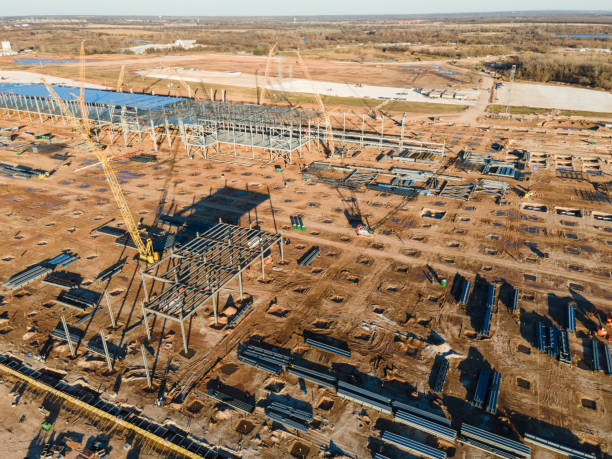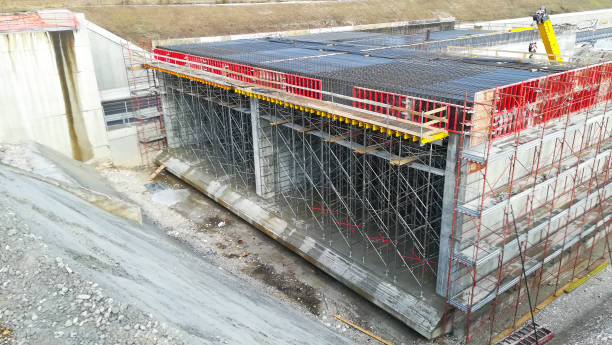Collaborative Reporting for Safer Structures UK (Cross UK) has issued a warning regarding the potential for the collapse of roofs with an “unusual” hybrid concrete and steel strand trusses, particularly those on “ageing” structures. The report concerns the partial collapse of a roof at a primary school due to the failure of one of these hybrid trusses. These trusses consist of a precast reinforced concrete top chord and verticals while the bottom chord is formed of tensioned steel strands. The building is believed to have been constructed in the 1950s. The failure of the truss led to the collapse of the supported flat roof and part of the adjacent roof, seen in the image above. Fortunately, the collapse occurred outside of school hours when the hall was not in use so nobody was harmed. The reporter who alerted Cross to the issue describes the hybrid trusses as spanning the 10m-wide hall, bearing on pockets in a precast ring beam that capped the external wall of the single-stored building. The trusses were spaced approximately 3.5m apart along the length of the building and supported precast concrete purlins (horizontal members that are supported by struts). Over these were wood wool slabs, insulation and a felt roofing finish. The bottom chord of the hybrid truss consisted of seven steel strands that extended its full length, between the anchorage plates cast into either end of the reinforced concrete top chord. The strands passed over four steel mounts located at the ends of concrete verticals, cast integral with the top chord. The top chord’s stability was provided by diaphragm action of the wood wool slabs, thin screed and purlins, which distributed the lateral loads to masonry cross walls. When the reporter, a structural engineer, visited the site soon after the collapse, they found that the roof truss had failed with six of the seven steel tensioning strands lying on the ground. The anchorage fixings for the detached end of the loose strands were found in the bearing pocket of the edge beam, while the anchorages for the other end of the strands remained with the top chord endplate. The purlins on either side had collapsed or were damaged and hanging from one end, but the felt roof was still intact and holding water.

The Reporter Considered That, At The Time of Construction.
The purlins would only have had a bearing of around 20mm and there was evidence that they had been bedded on mortar in pockets on top of the truss. It was also determined that, probably around the time of construction, a steel angle was fixed to the top chord of the trusses to provide additional support to the purlins, presumably owing to their small bearing width. The tensioned strands were held at the endplates using a cylinder with two serrated split wedges and these strands were carried over the concrete verticals on support rollers. The reporter said it is unclear how the truss was originally tensioned, but that there may have been initial tensioning at the factory followed by further tensioning prior to installation using the threads on the steel mounts to lengthen the verticals, thus tensioning the strands. The reporter goes on to say that concrete from the failed truss was tested in a laboratory and found not to have any significant defects. Some surface corrosion of the reinforcement was observed, but this could be expected from a concrete element of this age. However, the detailing of the reinforcement did not appear optimal to the reporter, who describes that the bars were lapped in the middle of the top chord with a non-standard detail while the reinforcement did not fully extend to the beam end and the bearing appeared to be minimally reinforced. They also reported minimal link reinforcement at the end of the beam where the anchorages failed, although there was no shear cracking at the end of the failed truss. Surface corrosion to the anchor plates was observed, but no loss of section was visible. Testing confirmed that the concrete in the purlins was made using high alumina cement. Degradation was apparent in some of the purlins which suggests that conversion had taken place and reduced their structural integrity. The reporter’s inspection did not identify any significant cracking or distress to the hall structure below the eaves level concrete ring beam. The reporter believed the failure possibly resulted from anchorages of the tensioning strands slipping suddenly without warning. This could have led to a global failure of the truss in bending, as witnessed by the significant deflection and damage that occurred at the center of the span. The reporter reasoned that once the anchorages had slipped, tension was lost in the strands and, owing to the poor detailing of the reinforcement at mid span, combined with the reduced capacity of the concrete chord, the truss likely failed in bending at mid span and collapsed. This caused the purlins to become dislodged and the roof structure in the two bays on either side of the truss to fail and deflect or collapse to the ground.

The Reporter Believes That The Truss System Was Inherently.
Defective and had been exacerbated by creep and age. Poor reinforcement detailing and poor detailing of bearing notches for concrete roof purlins may also have contributed to the collapse. The roofing felt was watertight and held a considerable amount of water subsequent to demolition, but there is no evidence of water accumulation at roof level prior to the collapse. There was no evidence that the roof drainage was defective. The reporter wishes the details of the failure to be disseminated so that trusses of this type in schools or other buildings can be identified and appropriate measures be taken. Commenters on the expert panel said: “Variations of the reported concrete structure have been used in bridges, and a similar structural system has also been used in timber trusses. A concrete truss system where precast units were transported to site and then stressed together is also known to have been manufactured. This collapse serves to emphasize that bodies responsible for the safety of buildings must be aware that novel structural systems, as illustrated in this case, may pose safety risks.” On the cause of collapse, they added: “A number of causes could be postulated, and it is likely that a combination of causes led to the collapse. A failure of a tendon or tendon anchorage is one potential cause. Movements at the truss end bearing could be a contributory cause, promoting crack development around the anchorage and loss of anchorage or disruption of the top chord. Creep stretching of the tendons causing sagging of the truss and the potential for rainwater ponding could be an exacerbating factor. Replacement roof coverings could have also had an impact over time.” Cross recommends that responsible bodies or persons arrange for appropriate inspection and assessment of buildings that contain unusual forms of construction, including roofs similar to the reported failure, and take appropriate action following the assessment.


Recent Comments